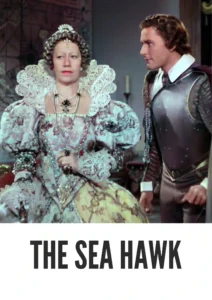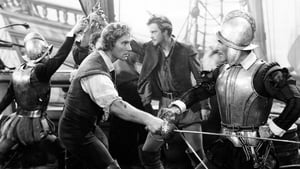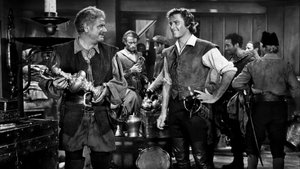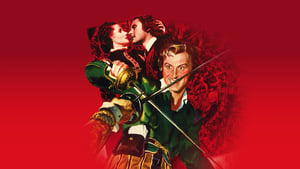Contact: info@alwanfilm.com
Video Sources 0 Views

Synopsis
The Sea Hawk 1940 Colorized Review: A Swashbuckling Adventure in Early Color

Introduction
“The Sea Hawk” (1940) stands as one of the great swashbuckling epics of the Golden Age of Hollywood. Directed by Michael Curtiz and starring Errol Flynn, the film is a rousing adventure that takes audiences on a journey across the seas, filled with political intrigue, daring escapades, and larger-than-life characters. Released at a time when the world was on the brink of World War II, the film’s themes of freedom, patriotism, and defiance against tyranny resonated deeply with contemporary audiences.
Although originally released in black and white, “The Sea Hawk” was later colorized, offering a new visual perspective on this classic. In this article, we’ll explore how the film’s colorized version enhances the storytelling, its significance in film history, and the impact of its legendary performances. We will also discuss the art of colorization itself and how it fits into the broader debate of preserving the integrity of classic cinema.
Check The Full Colorized Movies List
Check Our Colorized Movies Trailer Channel
Understanding The Sea Hawk 1940 Colorized: Director, Cast, and Genre
“The Sea Hawk” was directed by Michael Curtiz, a legendary filmmaker known for his versatility and ability to craft films across genres. Curtiz had already built a successful partnership with Errol Flynn by 1940, having directed him in a number of swashbucklers, including “Captain Blood” (1935) and “The Adventures of Robin Hood” (1938). “The Sea Hawk” was their fourth collaboration, and Curtiz once again demonstrated his knack for blending thrilling action sequences with emotional depth and complex political underpinnings.
Errol Flynn stars as Captain Geoffrey Thorpe, a dashing privateer in the service of Queen Elizabeth I, portrayed by Flora Robson. Flynn’s portrayal of Thorpe is one of his finest performances, embodying the charm, bravery, and moral conviction that made him a Hollywood icon. Flynn was at the peak of his career when he took on the role, and his swashbuckling charisma shines through in every scene. His effortless athleticism and boyish charm made him the perfect choice to lead audiences through this daring tale of naval warfare and espionage.
Flora Robson’s Queen Elizabeth I is another standout performance, bringing dignity and strength to the role. Her scenes with Flynn are some of the film’s highlights, as they convey the deep sense of patriotism and duty that drives the characters. Brenda Marshall plays the female lead, Doña Maria, a Spanish noblewoman torn between her loyalty to her country and her growing love for Thorpe. Her performance adds an emotional layer to the story, balancing the film’s action and political drama with a compelling romantic subplot.
The genre of “The Sea Hawk” is quintessentially that of the swashbuckler—a type of action-adventure film characterized by swordplay, heroism, and high-stakes adventure. However, it also contains elements of historical drama, as the story is set during the conflict between England and Spain in the late 16th century. The film weaves in themes of patriotism, liberty, and the fight against oppression, making it a timely allegory for the world events of the 1940s.
Exploring the World of The Sea Hawk 1940 Colorized: Plot and Characters
“The Sea Hawk” begins with Captain Geoffrey Thorpe and his crew of English privateers raiding Spanish galleons on the high seas. Thorpe is a loyal servant of Queen Elizabeth I, who secretly encourages such actions to weaken the Spanish Empire, though publicly she must denounce them. The film’s central conflict revolves around Spain’s efforts to build an armada to invade England, and Thorpe’s daring missions to thwart their plans.
The plot takes a turn when Thorpe captures a Spanish ship carrying Doña Maria, the niece of the Spanish ambassador. While initially adversaries, Thorpe and Maria soon develop feelings for each other, complicating Thorpe’s mission and his loyalties. This romantic subplot adds depth to the characters, particularly Thorpe, who must navigate his personal desires alongside his duty to Queen and country.
Throughout the film, Thorpe faces numerous challenges, including betrayal, imprisonment in Spain, and a dramatic escape sequence that showcases Flynn’s physical prowess and the film’s impressive set design. The climax builds to an epic naval battle, where Thorpe’s bravery and strategic genius come to the forefront. The final showdown on the high seas is one of the most thrilling sequences in classic cinema, combining innovative special effects, intricate choreography, and a stirring musical score.
The supporting characters in “The Sea Hawk” are also well-developed, each contributing to the film’s rich narrative tapestry. Henry Daniell plays the scheming Lord Wolfingham, an English noble who conspires with the Spanish to undermine Queen Elizabeth. His performance is delightfully sinister, adding a layer of intrigue and danger to the plot. The film also features Alan Hale as Thorpe’s loyal right-hand man, Carl Pitt, providing comic relief and a sense of camaraderie that lightens the film’s more serious moments.
The Art of Film Colorization
The process of film colorization has evolved significantly over the years, and “The Sea Hawk” underwent this transformation decades after its initial black-and-white release. Colorization involves digitally painting over black-and-white footage, frame by frame, to give the appearance of a full-color film. Early efforts at colorization were often criticized for their artificial look, as the technology struggled to replicate the natural hues and shadows that cinematographers originally intended. However, advancements in the field have made colorized versions of classic films more visually appealing.
The decision to colorize a film like “The Sea Hawk” is not without controversy. Many cinephiles argue that black-and-white films should be preserved in their original format, as the monochrome aesthetic is often integral to the director’s vision. However, proponents of colorization argue that it allows new generations of viewers to experience these films in a fresh, more accessible way.
Early Colored Films: A Brief History
The history of color in film is a fascinating journey of technical innovation and artistic experimentation. While color processes existed as early as the silent film era, they were often rudimentary and limited in scope. Early methods involved hand-painting individual frames or tinting entire scenes, techniques that were labor-intensive and inconsistent. The first true breakthrough came with Technicolor, which became the dominant color process in the 1930s and 1940s.
Technicolor was expensive, and not all studios could afford to use it, especially for large-scale productions like “The Sea Hawk.” As a result, many films from this era were shot in black and white, including some that might have benefited from color’s added depth and richness. It wasn’t until decades later, with the advent of digital colorization, that these films could be revisited and transformed into color versions.
“The Sea Hawk” and Its Early Colored Version
“The Sea Hawk” was originally filmed in black and white, a choice that reflected both the technological limitations and artistic decisions of the time. The film’s stark, high-contrast cinematography played a crucial role in creating its intense atmosphere, especially during the darker, more brooding scenes. The use of shadows and light gave the film a noir-like quality, enhancing the tension and drama of the narrative.
The later decision to colorize “The Sea Hawk” was part of a broader trend in the 1980s and 1990s, when studios sought to introduce classic films to a new generation of audiences. The colorized version of the film adds a different visual dimension, highlighting the lush costumes, grand sets, and the vast expanse of the ocean. Thorpe’s ship, the Albatross, and the elaborate period costumes take on new life in the colorized version, giving the film a more vibrant and immersive feel.
However, the colorized version also changes the tone of certain scenes, particularly those that rely on the dramatic interplay of light and shadow. The monochrome version’s more subdued visual palette helped accentuate the film’s darker themes of betrayal, espionage, and political intrigue, while the colorized version softens some of these edges.
The Debate Over Film Colorization
As with many classic films, the colorization of “The Sea Hawk” sparked debate among film historians and fans alike. The argument against colorization primarily centers around the notion of artistic integrity. Filmmakers of the past often used black and white intentionally, not just out of necessity. The stark contrasts of monochrome cinematography allowed directors to create moods and emotions that color sometimes fails to convey.
On the other hand, supporters of colorization argue that it breathes new life into old films, making them more appealing to modern audiences who may be turned off by black-and-white visuals. In the case of “The Sea Hawk,” the colorized version provides a new way to experience the film, adding a sense of visual spectacle that complements its epic scale.
Examining “The Sea Hawk” as an Early Colored Film
The colorization of “The Sea Hawk” presents an interesting case study in how color can both enhance and alter a film’s aesthetic. The sea battles, one of the film’s most thrilling aspects, are particularly stunning in color. The vibrant blues of the ocean, the rich tones of the ships’ sails, and the fiery explosions during naval combat scenes all come to life in a way that the black-and-white version, though atmospheric, could not fully capture.
Costumes, too, benefit from the transition to color. The film’s elaborate period attire, from Queen Elizabeth’s regal gowns to the uniforms of Thorpe’s crew, take on a new level of detail and richness. The visual spectacle of the film is heightened, drawing the viewer deeper into the world of 16th-century naval warfare and courtly intrigue.
However, the colorized version does lose some of the intensity that the original black-and-white cinematography brought to certain moments. Scenes of espionage and dark corridors, where shadows played a key role in building suspense, are less impactful when the color palette is introduced.
Influence and Legacy: The Sea Hawk 1940 Colorized’s Impact on Cinema
“The Sea Hawk” is a quintessential example of the swashbuckler genre and remains one of the defining films of Errol Flynn’s career. Its influence on later adventure films, particularly pirate and seafaring movies, is undeniable. Films like “Pirates of the Caribbean” owe a debt to “The Sea Hawk,” both in terms of their nautical settings and their tone of daring adventure.
The film’s influence extends beyond the swashbuckler genre, however. Its themes of patriotism, loyalty, and freedom resonated deeply with audiences during World War II, and it continues to be celebrated as a timeless tale of heroism. Michael Curtiz, already an established director by 1940, solidified his reputation as one of Hollywood’s most versatile filmmakers with “The Sea Hawk.”
Director’s Cinematic Legacy: Beyond The Sea Hawk 1940 Colorized
Michael Curtiz is perhaps best known for his direction of “Casablanca” (1942), a film that has become synonymous with cinematic excellence. However, “The Sea Hawk” remains one of his finest achievements in the action-adventure genre. Curtiz’s ability to balance character development with large-scale set pieces is on full display here, and his collaboration with Errol Flynn resulted in some of the most beloved films of the era.
Curtiz’s influence extends far beyond Hollywood, and his work continues to inspire filmmakers around the world. His use of dynamic camera movements, innovative special effects, and complex character dynamics set the standard for action films for decades to come.
Themes Explored in The Sea Hawk 1940 Colorized
“The Sea Hawk” delves into themes of loyalty, patriotism, and the fight for freedom. Set against the backdrop of England’s conflict with Spain, the film draws clear parallels between the historical tensions of the 16th century and the political climate of the 1940s. Thorpe’s unwavering commitment to Queen Elizabeth mirrors the resolve of those fighting against tyranny in World War II.
The film also explores the personal sacrifices made in the name of duty. Thorpe’s love for Doña Maria is tempered by his loyalty to his country, forcing him to choose between personal happiness and his greater mission. This tension between love and duty is a recurring theme in the film, adding emotional depth to the action-packed narrative.
Reception and Controversy Surrounding The Sea Hawk 1940 Colorized
Upon its release, “The Sea Hawk” was praised for its thrilling action sequences, strong performances, and timely themes. Critics lauded Flynn’s performance, with many calling it one of his best. The film’s stirring score by Erich Wolfgang Korngold, a frequent collaborator with Curtiz and Flynn, was also highly praised and remains one of the most celebrated film scores of the era.
The colorized version of “The Sea Hawk” sparked controversy, as many fans of the original black-and-white version felt that the new color palette diminished the film’s impact. While the colorization allowed new audiences to discover the film, purists argued that it undermined Curtiz’s artistic vision.
Where to Watch The Sea Hawk 1940 Colorized Online
Today, “The Sea Hawk” can be found on various streaming platforms, making it accessible to both longtime fans and new viewers alike. The black-and-white version is available on services like Amazon Prime, HBO Max, and Apple TV. The colorized version can be found on DVD and Blu-ray, often included as part of special edition releases of the film.
FAQs About The Sea Hawk 1940 Colorized
Q: Is “The Sea Hawk” based on a true story?
A: “The Sea Hawk” is a fictional story inspired by the exploits of English privateers during the reign of Queen Elizabeth I. While it incorporates historical elements, the characters and events are largely fictionalized.
Q: Was the film originally shot in black and white?
A: Yes, “The Sea Hawk” was originally filmed in black and white. The colorized version was released decades later.
Q: Where was “The Sea Hawk” filmed?
A: Much of the film was shot on soundstages at Warner Bros. Studios in Burbank, California. Some outdoor scenes were filmed on location, but most of the action was created using elaborate sets and special effects.
Q: Is “The Sea Hawk” connected to the 1924 silent film of the same name?
A: While both films share the same title and are based on Rafael Sabatini’s novel The Sea Hawk, the 1940 version deviates significantly from the book’s plot and is not considered a direct remake.
Conclusion
“The Sea Hawk” (1940) remains a landmark film in the swashbuckling genre, offering audiences a thrilling tale of high-seas adventure, political intrigue, and romance. Its later colorized version adds a new layer of visual spectacle, though the original black-and-white version still holds a special place in the hearts of purists. Whether experienced in color or monochrome, the film continues to captivate audiences with its timeless themes of heroism, loyalty, and the fight for freedom.
For anyone interested in classic Hollywood cinema, “The Sea Hawk” is a must-watch, offering a masterclass in action filmmaking and a stellar performance from Errol Flynn at the height of his career.














